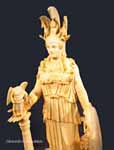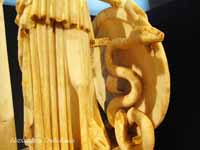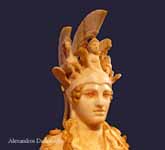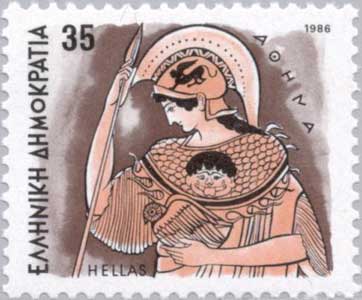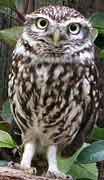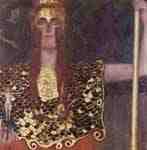.
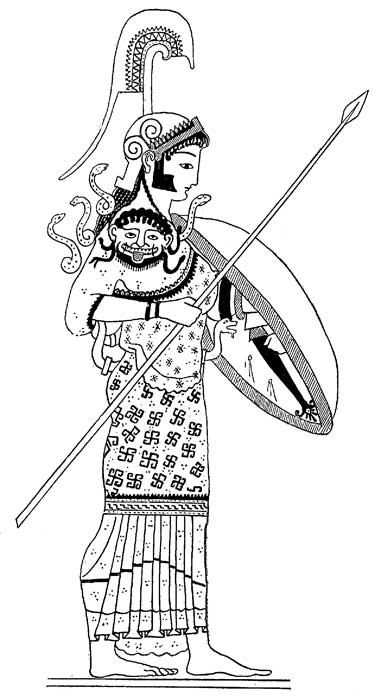
Athena, (Greek Αθηνα or Αθηνη, Αθηνά) also transliterated as Athene, the Greek goddess of wisdom, strategy, and war associated by the Etruscans with their goddess Menrva, and later by the Romans as Minerva, is attended by an owl, carried the goatskin shield given to her from her father called the Aegis and is accompanied by the goddess of victory, Nike. Athena is also a goddess associated with mentoring heroes. Athena is an armed warrior goddess, never a child, always a virgin, (parthenos). The Parthenon at Athens, Greece is her most famous shrine. She never had a consort or lover, although once Hephaestus tried and failed. Herodotus and Plato incorrectly identified Athena with the Libyan (The modern Berbers) goddess Neith.
Pallas is sometimes thought to be her father, hence the epithet Pallas Athena. Other stories say that Pallas was Athena's childhood friend. During a game, Athena accidentally killed Pallas. Athena then decided to put Pallas's name before hers so that Pallas will always be remembered.
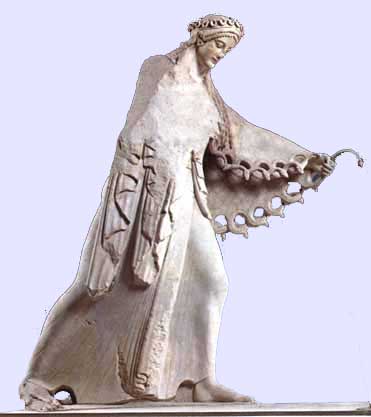
Athena, c. 520 BC, Acropolis Museum of Athens, Part of the East Pediment of a Temple on the Acropolis representing a gigantomachy
History
Athena was already a goddess in the Aegean before the coming of the Greeks. A-ta-na-po-ti-ni-ja (Mistress Athena) is referred to in the Knossos Linear B text V 2, cited by linguist John Chadwick. This is the Mycenaean attempt to translate the name of the Minoan goddess, A-ta-no-dju-wa-ja. This name means Sun Goddess - the prefix atano is related to Luwian astanus = sun, and the final part is the Minoan spelling of what we know from ancient Greek as Diwia (Mycenaean di-u-ja or di-wi-ja). The Mycenaeans even kept the Minoan word order at this early time. After the collapse of the Minoan civilisation, there is no longer any evidence Atano was worshipped as a sun goddess. During the Mycenaean period, Atana was absorbed into their pantheon and became a goddess who protected the royal palace and household. Athena is associated with Athens, a plural name because it was the place where she presided over her sisterhood, the Athenai, in earliest times.
In the Olympian pantheon, Athena was remade as the favorite daughter of Zeus, born by parthenogenesis from his forehead, the culmination of his Olympian ascendancy over the matriarchal Great Goddess of the earlier culture. Her birth is told in other versions. In one, Zeus lay with Metis, the goddess of crafty thought, but immediately feared the consequences. It had been prophesied that Metis would bear children more powerful than Zeus himself. In order to forestall these dire consequences, Zeus transformed Metis into a fly and swallowed her immediately after lying with her. He was too late: Metis had already conceived a child. Metis immediately began making a helmet and robe for her fetal daughter. The hammering as she made the helmet caused Zeus great pain and Prometheus, Hephaestus, Hermes or Palaemon (depending on the sources examined) cleaved Zeus's head with the double-headed Minoan axe ("labrys"). Athena leaped from Zeus's head, fully grown and armed, and Zeus was none the worse for the experience.
Athena was patron of the art of weaving and other crafts, wisdom and battle. Unlike Ares, who was hot-headed and undependable in battle, Athena's domain was strategy and tactics. Having taken the side of the Greeks in the war against Troy, Athena assisted the wily Odysseus on his journey home.
Athena in Art
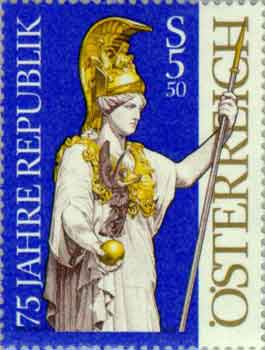
Stamp of Athena sculpture in Vienna, Austria
Athena is classically portrayed wearing full armor, carrying a lance and a shield with the head of the gorgon Medusa mounted on it. It is in this posture that she was depicted in Phidias's famous gold and ivory statue of her, now lost to history, in the Parthenon on the Athenian Acropolis. Athena is also often depicted with an owl (a symbol of wisdom) sitting on one of her shoulders.
In earlier, archaic portraits of Athena in vase-paintings, the goddess retains some of her Minoan character, such as great birdwings.
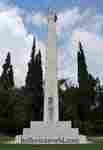
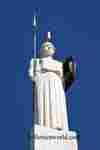
Appellations
It is interesting to note that, while Homer's epithet glaukopis for Athena is usually translated "bright-eyed," it is derived from glaux (owl). The bird which sees in the night is closely associated with the goddess of wisdom: in archaic images, she is frequently depicted with an owl perched on her head.
In her role as judge at Orestes' a trial on the murder of his mother, Clytemnestra (which he won), Athena won the epithet "Athena Areia."
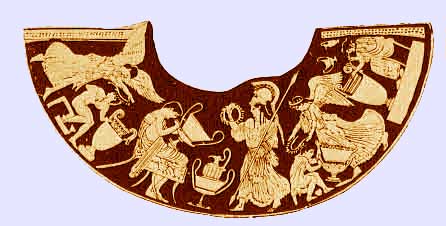
Athena Ergane
Athena was often associated with the local Aeginian goddess, Aphaea.
Alcis (Ἀλκίς), that is, the Strong. A surname of Athena, under which she was worshipped in Macedonia. (Liv. xlii. 51.)
Chalcioecus, " the goddess of the brazen house," a surname of Athena at Sparta, derived from the brazen temple which the goddess had in that city, and which also contained her statue in brass. This temple, which continued to exist in the time of Pausanias, was believed to have been commenced by Tyndareus, but was not completed till many years later by the Spartan artist Gitiadas. (Pausanias iii. 17. § 3, x. 5. § 5 ; C. Nep. Pausanias 5; Polyb. iv. 22.) Respecting the festival of the Chalcioecia celebrated at Sparta, see Dict. of Ant.
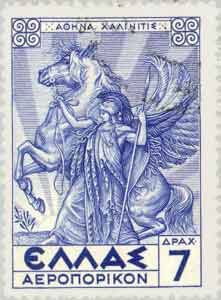
Athena Chalinitis with Pegasus.
Chalinitis, the tamer of horses by means of the bridle (chalinos), a surname of Athena, under which she had a temple at Corinth. In order to account for the name, it is related, that she tamed Pegasus and gave him to Bellerophontes, although the general character of the goddess is sufficient to explain the surname. This is the account that I read, and not far from the tomb is the temple of Athena Chalinitis (Bridler). For Athena, they say, was the divinity who gave most help to Bellerophontes, and she delivered to him Pegasus, having herself broken in and bridled him. The image of her is of wood, but face, hands and feet are of white marble. Pausanias 2.4.1
Ergane (Ἐργάνη) or Ergatis, that is, the worker, a surname of Athena, who was believed to preside over and instruct man in all kinds of arts. (Pausanias v. 14. 5, i. 24. 3; Plut. de Fort. p. 99, a.; Hesych. s. v.)
She was often referred to with the epithet "Pallas Athena". Pallas was an ambiguous figure, sometimes male sometimes female, never imagined apart from Athena. She killed Pallas in a mistake, and ever after wore her/his goatskin fringed with chthonic serpents, as the protective aegis.
Nedousia, a surname of Athena, under which she had a sanctuary on the river Nedon (from which she derived the name), and another at Poieessa in the island of Cos. The latter was said to have been founded by Nestor on his return from Troy, and to have derived its name from Nedon, a place in Laconia. (Strab. viii. p. 360, x. p. 487; Steph. Byz. s. v. Nedôn.)
Polias (Greek. Πολιάς), i. e. "the goddess protecting the city," a surname of Athena at Athens, where she was especially worshipped as the protecting divinity of the acropolis. (Pausanias i. 27. § I; Arnob. adv. Gent. vi. 193.)
Poliouchos, (gr. Πολιοῦχος), i.e. "protecting the city," occurs as a surname of several divinities, such as Athena Chalcioecus at Sparta. (Pausanias iii. 17. § 2), and of Athena at Athens.
With the epithet "Athena Parthenos" ("virgin"), Athena was worshipped at the Parthenon. With the epithet "Athena Promachos" she led in battle
.
The Aphaia Temple Pediment Sculptures (with Athena)
The Colossal Athena Parthenos Statue of Pheidias
|
Athena with the Aegis |
Little Owl ( Athene noctua) the bird of Athene |
Episodes
Erichthonius
According to Apollodorus, Hephaestus attempted to rape Athena but was unsuccessful. His semen fell on the ground, and Erichthonius was born from the earth. Athena then raised the baby as a foster mother. Alternatively, the semen landed on Athena's leg, and she wiped it off with a piece of wool which she tossed on the ground. Erichthonius arose from the ground and the wool. Another version says that Hephaestus wanted Athena to marry him but she disappeared on his bridal bed; he ejaculated onto the ground instead. Athena gave three sisters, Herse, Pandrosus and Aglaulus the baby in a small box and warned them to never open it. Aglaulus and Herse opened the box which contained the infant and future-king, Erichthonius. The sight caused Herse and Aglaulus to go insane and they threw themselves off the Acropolis.
An alternative version of the same story is that while Athena was gone to bring a mountain to use in the Acropolis, the two willful sisters opened the box. A crow witnessed the opening and flew away to tell Athena, who fell into a rage and dropped the mountain (now Mt. Lykabettos). Once again, Herse and Aglaulus went insane and threw themselves to their deaths off a cliff.
Erichthonius later became King of Athens and implemented many beneficial changes to Athenian culture. During this time, Athena frequently protected him.
Athens
Athena competed with Poseidon to be the patron deity of Athens. They agreed that each would give the Athenians one gift and the Athenians would choose whichever gift they preferred. Poseidon struck the ground with his trident and a spring sprung up; the water was salty and not very useful, whereas Athena offered them the first domesticated olive tree. The Athenians (or their king, Cecrops) accepted the olive tree and along with it Athena as their patron, for the olive tree brought wood, oil and food. This is thought to remember a clash between the inhabitants during Mycenaean times and newer immigrants. It is interesting to note that Athens at its height was a significant sea power, defeating the Persian fleet at the Battle of Salamis near Salamis Island in 480 BC. Athena was also the patron goddess of several other cities, notably Sparta. In an alternate version, Poseidon invents the first horse. Athena's gift is still chosen.
Arachne
A woman named Arachne once boasted that she was a superior weaver to Athena, the goddess of weaving. Athena appeared to her disguised as an old woman and told Arachne to repent for her hubris but Arachne instead challenged Athena to a contest. The old woman threw off her disguise and the contest began. Athena wove a depiction of the conflict with Poseidon over Athens, while Arachne wove a depiction of Zeus' many romantic exploits. Athena was furious at her skill (the contest was never decided), and her choice of subject, and, with a touch, struck Arachne with terrific guilt. Arachne tried to kill herself and Athena turned her into the first spider.
Perseus and Medusa
Athena guided Perseus in eliminating Medusa, a dangerous unreformed relic of the old pre-Olympian order, and she was awarded the grisly trophy that turned men to stone, for her shield.
Heracles
Athena instructed Heracles how to remove the skin from the Nemean Lion, by using the lion's own claws to cut through its thick hide. The lion's hide became Heracles' signature garment, along with the olive-wood club he used in the battle. Athena also assisted Heracles on a few other labors.
She also helped Heracles defeat the Stymphalian Birds, along with Hephaestus.
Tiresias and Chariclo
Athena blinded Tiresias after he stumbled onto her bathing naked. His mother, Chariclo, begged her to undo her curse, but Athena couldn't; she gave him prophecy instead.
Miscellaneous
Athena (Minerva) is the subject of the $50 1915-S Panama-Pacific commemorative coin. At 2.5 troy oz (78 g) gold, this is the largest (by weight) coin ever produced by the U.S. Mint. This was the first $50 coin issued by the U.S. Mint and no higher was produced until the production of the $100 platinum coins in 1997. Of course, in terms of face-value in adjusted dollars, the 1915 is the highest denomination ever issued by the U.S. Mint.
A full-scale replica of the Parthenon has stood in Nashville, Tennessee, which is known as the Athens of the South, for over a century. In 1990, a great replica of Phidias' statue of the goddess was added, over 41 feet (12.5 m) tall and gilded.
Together with Phoebus, Athena was the mascot of the 2004 Summer Olympics in Athens.
Music
Iannis Xenakis (May 29, 1922 Romania - February 4, 2001) La Déesse Athéna (Oresteïa III) (1992), for baritone solo and mixed ensemble of 11 instruments
| Ancient Greece
Science, Technology , Medicine , Warfare, , Biographies , Life , Cities/Places/Maps , Arts , Literature , Philosophy ,Olympics, Mythology , History , Images Medieval Greece / Byzantine Empire Science, Technology, Arts, , Warfare , Literature, Biographies, Icons, History Modern Greece Cities, Islands, Regions, Fauna/Flora ,Biographies , History , Warfare, Science/Technology, Literature, Music , Arts , Film/Actors , Sport , Fashion --- |
Retrieved from "http://en.wikipedia.org"
All text is available under the terms of the GNU Free Documentation License


